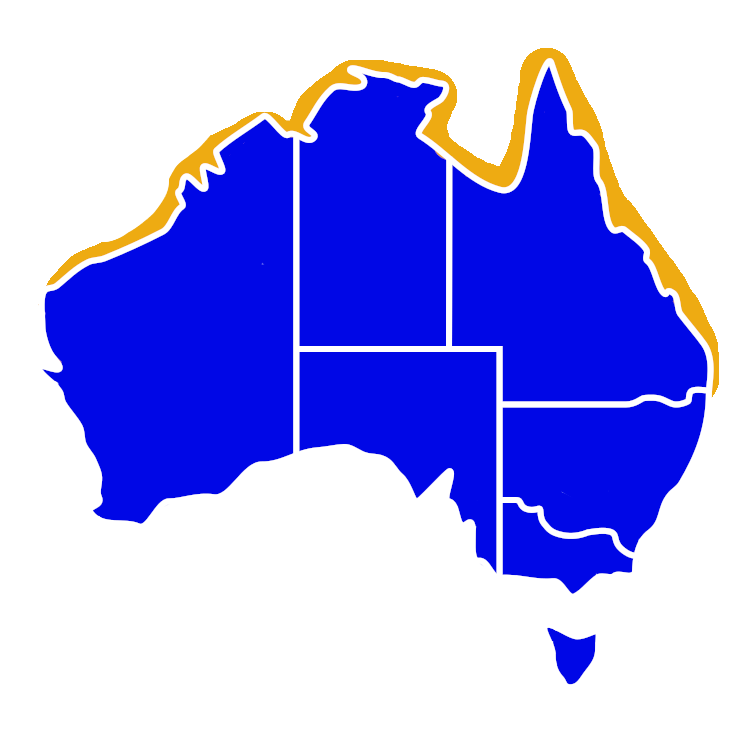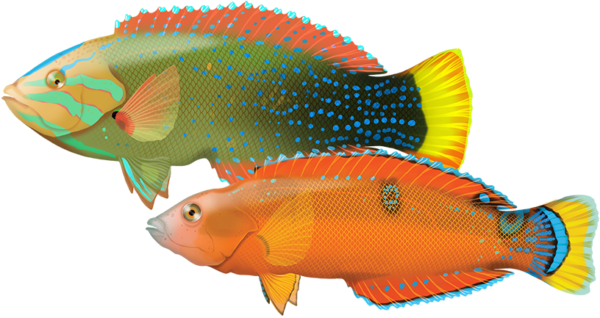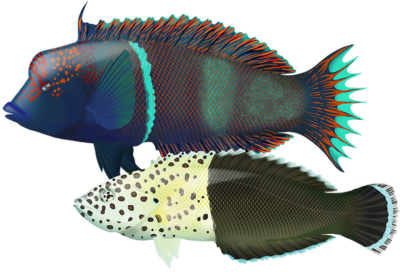Quick Facts
Distribution

Interesting Info
- The Clown Wrasse, also known as the Gaimard’s Wrasse, is a species of fish that belongs to the family Labridae and is found in the waters of northern Australia’s from the Great Barrier Reef in Queensland to Western Australia.
- The male Clown Wrasse is a strikingly beautiful fish with a distinctive appearance. As they mature, their body changes from the bright orange of juveniles to a rich, electric blue colour with a yellow dorsal fin and tail. They have a prominent black stripe that runs from their eye to the base of their tail, which is bordered by a thin white stripe.
- They are carnivorous and primarily feed on small invertebrates such as crustaceans and molluscs.
- These fish are known to form loose schools or shoals with other members of their species, particularly during spawning periods.
- Clown Wrasse are known to be particularly susceptible to parasitic infections, particularly from the copepod Pseudoleptocaris.
- The Clown Wrasse is known to have a relatively slow growth rate compared to other fish species. It can take up to five years for a juvenile Clown Wrasse to reach sexual maturity, and they may not change sex until they are 10 years old or older.
- They have been observed exhibiting a unique behaviour called “tail-standing,” where it stands on its head and tail and appears to dance in place, it is believed to be a form of communication or territorial display.
- During breeding season, males will perform a distinctive courtship display to attract females, including changing colour and flashing their fins.
- Estimated lifespan is up to 15 years.
Species Interaction
Recreational Fishing, Aquarium, Snorkeling & Diving
Clown wrasse are often caught as bycatch for anglers targeting other species. They are typically a catch and release species. They are more known for their striking colours and are a popular species for aquariums and to observe in the wild for snorkelers and divers. As they are a larger fish, they often seen in commercial viewing aquariums instead of home aquariums.
Scientific Classification
Kingdom: Animalia
Phylum: Chordata
Class: Actinopterygii
Order: Perciformes
Family: Labridae
Genus: Coris
Species: Coris Gaimard
Conservation Status
The Clown Wrasse is currently classified as a “vulnerable” species in Australia by the International Union for Conservation of Nature (IUCN) Red List. This means that the species is considered to be at high risk of endangerment in the wild due to a range of potential threats, including habitat loss, overfishing, and climate change.
Fish Taste Quality
Clown wrasse are a vulnerable species and should not be eaten. They are generally considered bycatch and released.
Taste Rating: NA
How to catch
Clown Wrasse
Catch Difficulty: Easy
Tackle: Running Sinker Rig
Bait: Crab, Fresh cut flesh baits, Pilchards, Prawns, Squid, Worms
Technique: Keep bait on the bottom, Keep bait close to the reef/structure
Popularity: Not targeted - Bycatch
Clown Wrasse
As Aquarium Fish
Care Level: Difficult
Temperament: Peaceful
Diet: Carnivore
Reef Compatible: Yes
Minimum Tank Size: 130 gallons
Recreational Viewing
- Snorkeling & Scuba
Finding: Easy
Temperament: Curious
Location: Inner Reef, Outer Reef, Lagoon
Danger: None





